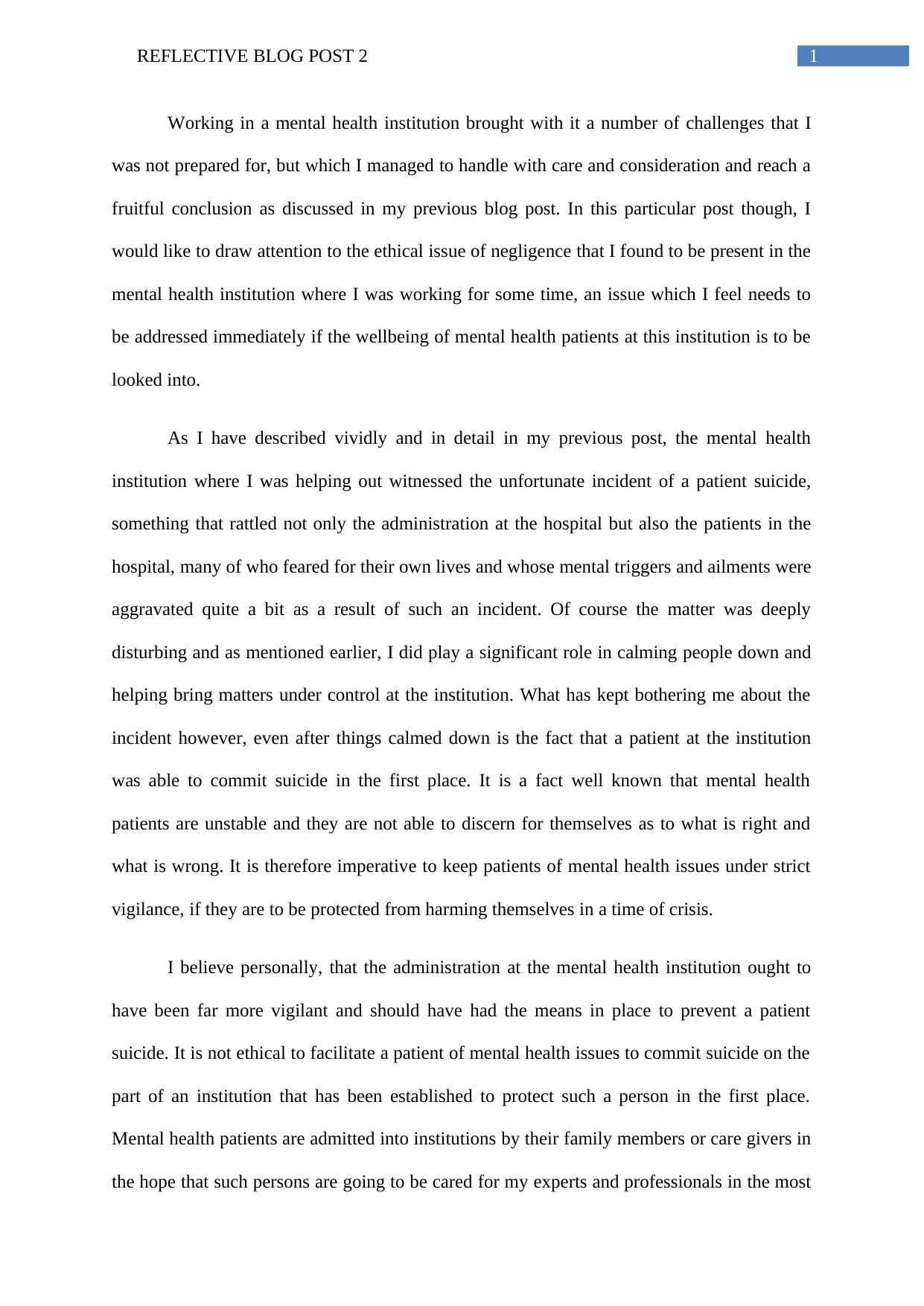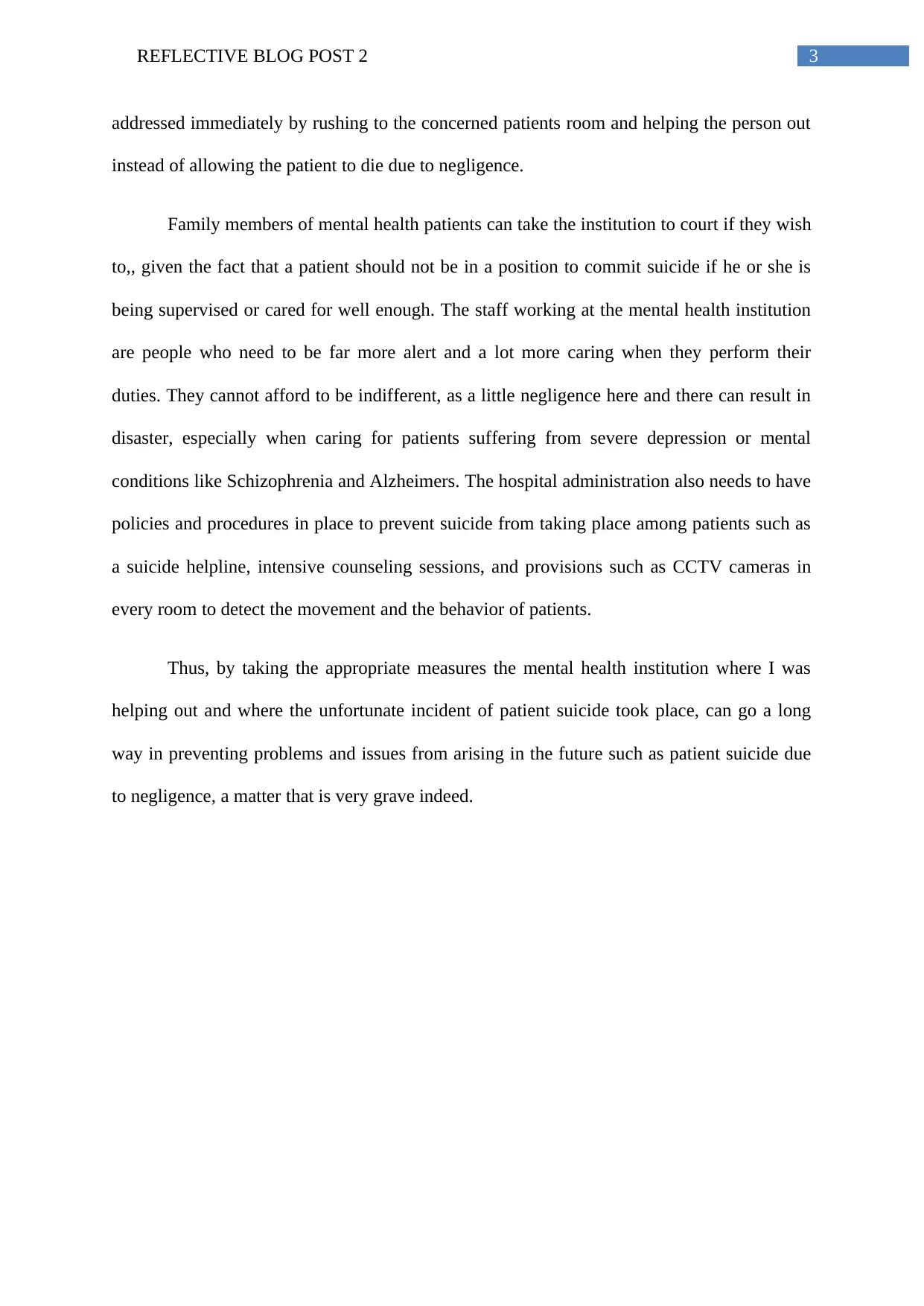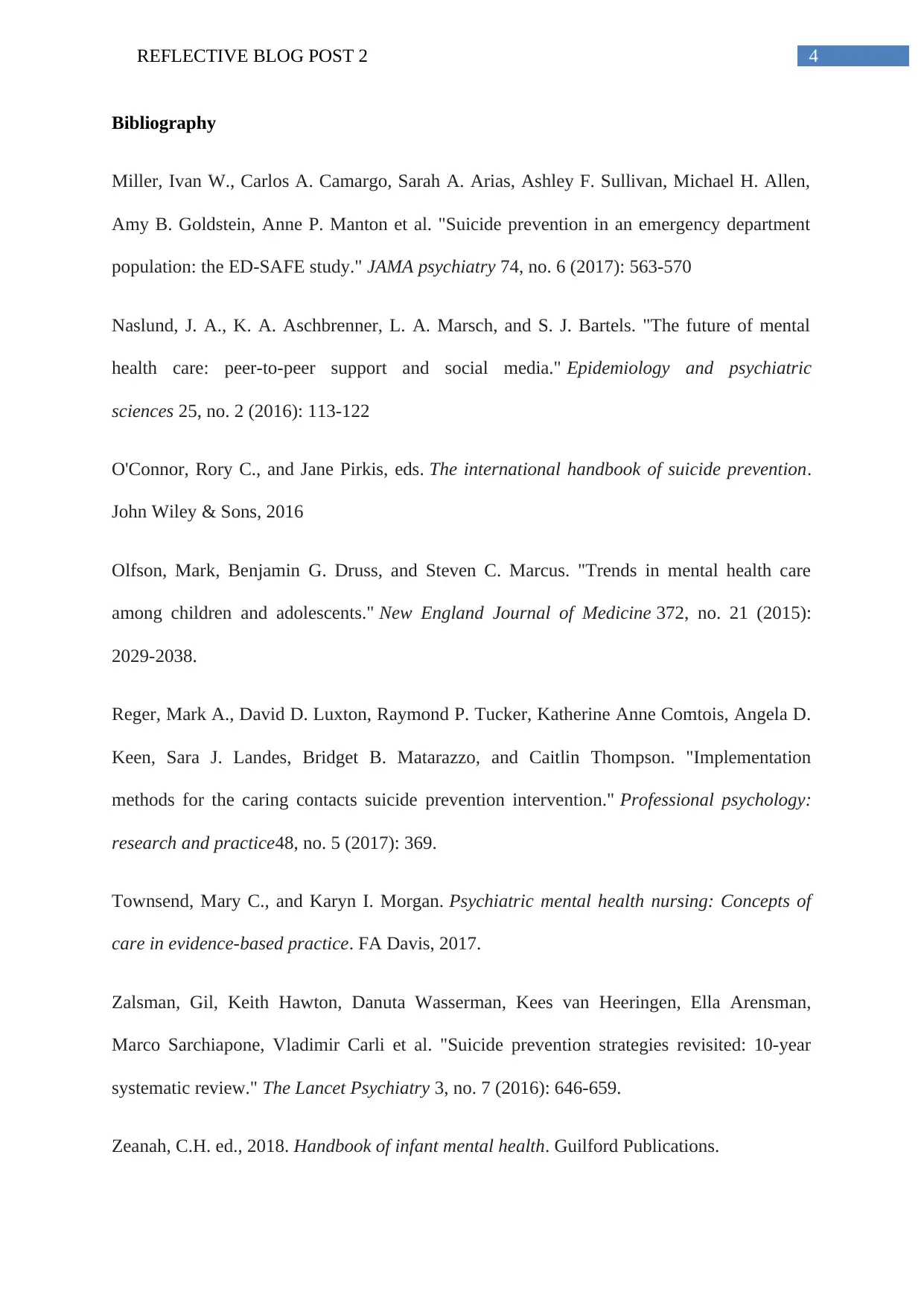Reflective Blog Post 2: Analysis of Patient Suicide in Mental Health
VerifiedAdded on 2023/01/23
|5
|1417
|43
Journal and Reflective Writing
AI Summary
This reflective blog post analyzes a distressing patient suicide incident within a mental health institution, highlighting critical ethical concerns and negligence. The author, a student, details the incident and its impact, emphasizing the vulnerability of mental health patients and the need for stringent vigilance. The post critiques the institution's practices, particularly staff stress and inadequate surveillance, which contributed to the patient's death. The author advocates for improved measures, including CCTV cameras, enhanced staff training, and a supportive environment. The blog post references relevant literature and stresses the importance of proactive strategies like suicide helplines and intensive counseling to prevent future tragedies. The core argument is that the institution must prioritize patient safety through comprehensive policies and staff accountability to prevent further instances of patient suicide resulting from negligence.

Running Head: REFLECTIVE BLOG POST 2
Reflective Blog Post 2
Name of the Student
Name of the University
Author Note
Reflective Blog Post 2
Name of the Student
Name of the University
Author Note
Paraphrase This Document
Need a fresh take? Get an instant paraphrase of this document with our AI Paraphraser

1REFLECTIVE BLOG POST 2
Working in a mental health institution brought with it a number of challenges that I
was not prepared for, but which I managed to handle with care and consideration and reach a
fruitful conclusion as discussed in my previous blog post. In this particular post though, I
would like to draw attention to the ethical issue of negligence that I found to be present in the
mental health institution where I was working for some time, an issue which I feel needs to
be addressed immediately if the wellbeing of mental health patients at this institution is to be
looked into.
As I have described vividly and in detail in my previous post, the mental health
institution where I was helping out witnessed the unfortunate incident of a patient suicide,
something that rattled not only the administration at the hospital but also the patients in the
hospital, many of who feared for their own lives and whose mental triggers and ailments were
aggravated quite a bit as a result of such an incident. Of course the matter was deeply
disturbing and as mentioned earlier, I did play a significant role in calming people down and
helping bring matters under control at the institution. What has kept bothering me about the
incident however, even after things calmed down is the fact that a patient at the institution
was able to commit suicide in the first place. It is a fact well known that mental health
patients are unstable and they are not able to discern for themselves as to what is right and
what is wrong. It is therefore imperative to keep patients of mental health issues under strict
vigilance, if they are to be protected from harming themselves in a time of crisis.
I believe personally, that the administration at the mental health institution ought to
have been far more vigilant and should have had the means in place to prevent a patient
suicide. It is not ethical to facilitate a patient of mental health issues to commit suicide on the
part of an institution that has been established to protect such a person in the first place.
Mental health patients are admitted into institutions by their family members or care givers in
the hope that such persons are going to be cared for my experts and professionals in the most
Working in a mental health institution brought with it a number of challenges that I
was not prepared for, but which I managed to handle with care and consideration and reach a
fruitful conclusion as discussed in my previous blog post. In this particular post though, I
would like to draw attention to the ethical issue of negligence that I found to be present in the
mental health institution where I was working for some time, an issue which I feel needs to
be addressed immediately if the wellbeing of mental health patients at this institution is to be
looked into.
As I have described vividly and in detail in my previous post, the mental health
institution where I was helping out witnessed the unfortunate incident of a patient suicide,
something that rattled not only the administration at the hospital but also the patients in the
hospital, many of who feared for their own lives and whose mental triggers and ailments were
aggravated quite a bit as a result of such an incident. Of course the matter was deeply
disturbing and as mentioned earlier, I did play a significant role in calming people down and
helping bring matters under control at the institution. What has kept bothering me about the
incident however, even after things calmed down is the fact that a patient at the institution
was able to commit suicide in the first place. It is a fact well known that mental health
patients are unstable and they are not able to discern for themselves as to what is right and
what is wrong. It is therefore imperative to keep patients of mental health issues under strict
vigilance, if they are to be protected from harming themselves in a time of crisis.
I believe personally, that the administration at the mental health institution ought to
have been far more vigilant and should have had the means in place to prevent a patient
suicide. It is not ethical to facilitate a patient of mental health issues to commit suicide on the
part of an institution that has been established to protect such a person in the first place.
Mental health patients are admitted into institutions by their family members or care givers in
the hope that such persons are going to be cared for my experts and professionals in the most

2REFLECTIVE BLOG POST 2
competent way possible. The fact that a patient can commit suicide within the premises of the
mental health institution is shocking and terrible and had the hospital staff been more careful
in this matter, the unfortunate incident would not have occurred. As mentioned before, the
staff at the mental health institution where I was helping out are under a lot of stress and
duress for the most part, and are often told off by members of higher authority from time to
time, often in a way that is demeaning and unkind and which hurts their self esteem. I have
stated earlier that the institution needs to be far more sensitive about the way in which it
treats its staff members, if it is to get its workers to be productive and do their best for the
patients who are entrusted in their care, rather than leaving them to die on account of sheer
negligence. The patient who committed suicide at the institution would not have been able to
do this in the first place, had there been adequate surveillance measures in place to detect any
suspicious behavior on the part of the patient, and had the care givers at the mental health
institution been more vigilant of the behavior and movements of their patients instead of
being negligent in their duties.
While a lot of damage control has already been done at the mental health institution
where the patient suicide took place, and while attempts are being made to modify work
standards and practices so that workers feel less intimated by the higher management and
more motivated towards the work that they do, new efforts and measures need to be put in
place to make sure that patients do not get the opportunity to commit suicide or take their
own lives because of the negligence of people who are supposed to be supervising them.
Surveillance mechanisms like CCTV cameras need to be installed in all the rooms of the
mental health institution so that the movement of patients can be monitored with ease. First
aid and other provisions need to be in place so that if an unfortunate incident takes place, like
the prospect of a patient trying to commit suicide, the hospital staff can get the matter
competent way possible. The fact that a patient can commit suicide within the premises of the
mental health institution is shocking and terrible and had the hospital staff been more careful
in this matter, the unfortunate incident would not have occurred. As mentioned before, the
staff at the mental health institution where I was helping out are under a lot of stress and
duress for the most part, and are often told off by members of higher authority from time to
time, often in a way that is demeaning and unkind and which hurts their self esteem. I have
stated earlier that the institution needs to be far more sensitive about the way in which it
treats its staff members, if it is to get its workers to be productive and do their best for the
patients who are entrusted in their care, rather than leaving them to die on account of sheer
negligence. The patient who committed suicide at the institution would not have been able to
do this in the first place, had there been adequate surveillance measures in place to detect any
suspicious behavior on the part of the patient, and had the care givers at the mental health
institution been more vigilant of the behavior and movements of their patients instead of
being negligent in their duties.
While a lot of damage control has already been done at the mental health institution
where the patient suicide took place, and while attempts are being made to modify work
standards and practices so that workers feel less intimated by the higher management and
more motivated towards the work that they do, new efforts and measures need to be put in
place to make sure that patients do not get the opportunity to commit suicide or take their
own lives because of the negligence of people who are supposed to be supervising them.
Surveillance mechanisms like CCTV cameras need to be installed in all the rooms of the
mental health institution so that the movement of patients can be monitored with ease. First
aid and other provisions need to be in place so that if an unfortunate incident takes place, like
the prospect of a patient trying to commit suicide, the hospital staff can get the matter
⊘ This is a preview!⊘
Do you want full access?
Subscribe today to unlock all pages.

Trusted by 1+ million students worldwide

3REFLECTIVE BLOG POST 2
addressed immediately by rushing to the concerned patients room and helping the person out
instead of allowing the patient to die due to negligence.
Family members of mental health patients can take the institution to court if they wish
to,, given the fact that a patient should not be in a position to commit suicide if he or she is
being supervised or cared for well enough. The staff working at the mental health institution
are people who need to be far more alert and a lot more caring when they perform their
duties. They cannot afford to be indifferent, as a little negligence here and there can result in
disaster, especially when caring for patients suffering from severe depression or mental
conditions like Schizophrenia and Alzheimers. The hospital administration also needs to have
policies and procedures in place to prevent suicide from taking place among patients such as
a suicide helpline, intensive counseling sessions, and provisions such as CCTV cameras in
every room to detect the movement and the behavior of patients.
Thus, by taking the appropriate measures the mental health institution where I was
helping out and where the unfortunate incident of patient suicide took place, can go a long
way in preventing problems and issues from arising in the future such as patient suicide due
to negligence, a matter that is very grave indeed.
addressed immediately by rushing to the concerned patients room and helping the person out
instead of allowing the patient to die due to negligence.
Family members of mental health patients can take the institution to court if they wish
to,, given the fact that a patient should not be in a position to commit suicide if he or she is
being supervised or cared for well enough. The staff working at the mental health institution
are people who need to be far more alert and a lot more caring when they perform their
duties. They cannot afford to be indifferent, as a little negligence here and there can result in
disaster, especially when caring for patients suffering from severe depression or mental
conditions like Schizophrenia and Alzheimers. The hospital administration also needs to have
policies and procedures in place to prevent suicide from taking place among patients such as
a suicide helpline, intensive counseling sessions, and provisions such as CCTV cameras in
every room to detect the movement and the behavior of patients.
Thus, by taking the appropriate measures the mental health institution where I was
helping out and where the unfortunate incident of patient suicide took place, can go a long
way in preventing problems and issues from arising in the future such as patient suicide due
to negligence, a matter that is very grave indeed.
Paraphrase This Document
Need a fresh take? Get an instant paraphrase of this document with our AI Paraphraser

4REFLECTIVE BLOG POST 2
Bibliography
Miller, Ivan W., Carlos A. Camargo, Sarah A. Arias, Ashley F. Sullivan, Michael H. Allen,
Amy B. Goldstein, Anne P. Manton et al. "Suicide prevention in an emergency department
population: the ED-SAFE study." JAMA psychiatry 74, no. 6 (2017): 563-570
Naslund, J. A., K. A. Aschbrenner, L. A. Marsch, and S. J. Bartels. "The future of mental
health care: peer-to-peer support and social media." Epidemiology and psychiatric
sciences 25, no. 2 (2016): 113-122
O'Connor, Rory C., and Jane Pirkis, eds. The international handbook of suicide prevention.
John Wiley & Sons, 2016
Olfson, Mark, Benjamin G. Druss, and Steven C. Marcus. "Trends in mental health care
among children and adolescents." New England Journal of Medicine 372, no. 21 (2015):
2029-2038.
Reger, Mark A., David D. Luxton, Raymond P. Tucker, Katherine Anne Comtois, Angela D.
Keen, Sara J. Landes, Bridget B. Matarazzo, and Caitlin Thompson. "Implementation
methods for the caring contacts suicide prevention intervention." Professional psychology:
research and practice48, no. 5 (2017): 369.
Townsend, Mary C., and Karyn I. Morgan. Psychiatric mental health nursing: Concepts of
care in evidence-based practice. FA Davis, 2017.
Zalsman, Gil, Keith Hawton, Danuta Wasserman, Kees van Heeringen, Ella Arensman,
Marco Sarchiapone, Vladimir Carli et al. "Suicide prevention strategies revisited: 10-year
systematic review." The Lancet Psychiatry 3, no. 7 (2016): 646-659.
Zeanah, C.H. ed., 2018. Handbook of infant mental health. Guilford Publications.
Bibliography
Miller, Ivan W., Carlos A. Camargo, Sarah A. Arias, Ashley F. Sullivan, Michael H. Allen,
Amy B. Goldstein, Anne P. Manton et al. "Suicide prevention in an emergency department
population: the ED-SAFE study." JAMA psychiatry 74, no. 6 (2017): 563-570
Naslund, J. A., K. A. Aschbrenner, L. A. Marsch, and S. J. Bartels. "The future of mental
health care: peer-to-peer support and social media." Epidemiology and psychiatric
sciences 25, no. 2 (2016): 113-122
O'Connor, Rory C., and Jane Pirkis, eds. The international handbook of suicide prevention.
John Wiley & Sons, 2016
Olfson, Mark, Benjamin G. Druss, and Steven C. Marcus. "Trends in mental health care
among children and adolescents." New England Journal of Medicine 372, no. 21 (2015):
2029-2038.
Reger, Mark A., David D. Luxton, Raymond P. Tucker, Katherine Anne Comtois, Angela D.
Keen, Sara J. Landes, Bridget B. Matarazzo, and Caitlin Thompson. "Implementation
methods for the caring contacts suicide prevention intervention." Professional psychology:
research and practice48, no. 5 (2017): 369.
Townsend, Mary C., and Karyn I. Morgan. Psychiatric mental health nursing: Concepts of
care in evidence-based practice. FA Davis, 2017.
Zalsman, Gil, Keith Hawton, Danuta Wasserman, Kees van Heeringen, Ella Arensman,
Marco Sarchiapone, Vladimir Carli et al. "Suicide prevention strategies revisited: 10-year
systematic review." The Lancet Psychiatry 3, no. 7 (2016): 646-659.
Zeanah, C.H. ed., 2018. Handbook of infant mental health. Guilford Publications.
1 out of 5